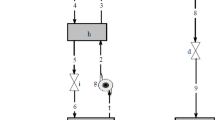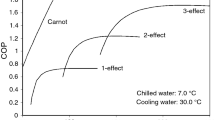Abstract
Renewable cooling via absorption chillers being supplied by various green heat technologies such as solar collectors has been widely studied in the literature, but it is still challenging to get positive economic outcomes from such systems due to the large expenses of solar thermal systems. This study offers the use of a new generation of solar collectors, so-called eccentric reflective solar collectors, for driving single-effect absorption chillers and thereby reducing the levelized cost of cooling. This article develops the most optimal design of this system (based on several different scenarios) using multi-objective optimization techniques and employs them for a case study in Brazil to assess its proficiency compared to conventional solar-driven cooling methods. For making the benchmarking analyses fair, the conventional system is also rigorously optimized in terms of design and operation features. The results show that the eccentric solar collector would enhance the cost-effectiveness by 29%. In addition, using optimally sized storage units would be necessary to get acceptable economic performance from the system, no matter which collector type is used. For the case study, at the optimal sizing and operating conditions, the levelized cost of cooling will be 124 USD/MWh and an emission level of 18.97 kgCO2/MWh.

















Similar content being viewed by others
Data availability
The data are available on request from the authors.
Abbreviations
- A :
-
Area, m2
- C :
-
Concentration
- cp :
-
Specific heat (J/(kg K))
- D :
-
Diameter, m
- F :
-
Shape factor
- h :
-
Heat transfer coefficient (W/(m22 K))
- h :
-
Enthalpy (J)
- I :
-
Incident solar radiation (W/m2)
- k :
-
Thermal conductivity (W/(m K))
- \(\dot{m}\) :
-
Mass flow rate (kg/s)
- P :
-
Pressure (Pa)
- Pr :
-
Prandtl number
- \(\dot{Q}\) :
-
Heat flow (W)
- \(\dot{q}\) :
-
Heat flow per unit area (W/m2)
- r :
-
Interest rate
- R :
-
Radius (m)
- Re :
-
Reynolds number
- S :
-
Source term
- T :
-
Temperature (°C)
- t :
-
Time (s)
- U :
-
Overall heat transfer coefficient (W/m2.K)
- u :
-
Velocity in x-axis (m/s)
- v :
-
Velocity in r-axis (m/s)
- \(x\) :
-
Liquid volume fraction
- α :
-
Absorptivity
- ε :
-
Emissivity
- µ :
-
Dynamic viscosity ((N s)/m2)
- ρ :
-
Density (kg/m3)
- σ :
-
Stefan-Boltzmann constant (W/(m2 K4))
- τ :
-
Transmissivity
- ϖ :
-
Generic extensive property
- ζ :
-
Maximum error
- a :
-
Absorber tube
- abs :
-
Chiller absorber
- c :
-
Cover
- cond :
-
Codenser
- conv :
-
Convection
- env :
-
Environment
- eva :
-
Evaporator
- ext :
-
External
- gen :
-
Desorber
- HEx :
-
Heat exchanger
- h :
-
Hot
- int :
-
Internal
- rad :
-
Radiation
- CFC :
-
Chlorofluorocarbon gas
- CCGT :
-
Combined cycle gas turbine
- COP :
-
Coefficient of performance
- ETC :
-
Evacuated tube collector
- GHG :
-
Greenhouse gas emission
- LCOC :
-
Levelized cost of cooling
- LHV :
-
Lower calorific value
- SIMPLE :
-
Semi-implicit method for pressure-linked equations
- TDMA :
-
Tri-diagonal matrix algorithm
References
ABNT (2003) Desempenho térmico de edificações Parte 2 : Métodos de cálculo da transmitância térmica , da capacidade térmica , do atraso térmico e do fator solar de elementos e componentes de edificações. ASSOCIAÇÃO BRASILEIRA DE NORMAS TÉCNICAS-ABNT, Rio de Janeiro
Al-Falahi A, Alobaid F, Epple B (2020) Design and thermo-economic comparisons of an absorption air conditioning system based on parabolic trough and evacuated tube solar collectors. Energies (Basel) 13. https://doi.org/10.3390/en13123198
Alsagri AS, Alrobaian AA, Almohaimeed SA (2020) Concentrating solar collectors in absorption and adsorption cooling cycles: an overview. Energy Convers Manag 223:113420. https://doi.org/10.1016/j.enconman.2020.113420
Asadi R, Assareh E, Moltames R et al (2022) Optimisation of combined cooling, heating and power (CCHP) systems incorporating the solar and geothermal energy: a review study. Int J Ambient Energy 43:42–60
Ascione F (2017) Energy conservation and renewable technologies for buildings to face the impact of the climate change and minimize the use of cooling. Sol Energy 154:34–100. https://doi.org/10.1016/j.solener.2017.01.022
Assareh E, Alirahmi SM, Ahmadi P (2021) A sustainable model for the integration of solar and geothermal energy boosted with thermoelectric generators (TEGs) for electricity, cooling and desalination purpose. Geothermics 92:102042. https://doi.org/10.1016/j.geothermics.2021.102042
Assareh E, Assareh M, Alirahmi SM et al (2022) Thermodynamic assessment of a cogeneration system with CSP driven-Brayton and Rankine cycles for electric power and hydrogen production in the framework of the energy and water nexus. Energy Nexus 5:100031
Assilzadeh F, Kalogirou SA, Ali Y, Sopian K (2005) Simulation and optimization of a LiBr solar absorption cooling system with evacuated tube collectors. Renew Energy 30:1143–1159. https://doi.org/10.1016/j.renene.2004.09.017
Behzadi A, Arabkoohsar A, Sadi M, Chakravarty KH (2021) A novel hybrid solar-biomass design for green off-grid cold production, techno-economic analysis and optimization. Sol Energy 218:639–651. https://doi.org/10.1016/j.solener.2021.02.065
Bellos E, Tzivanidis C, Antonopoulos KA (2016) Exergetic, energetic and financial evaluation of a solar driven absorption cooling system with various collector types. Appl Therm Eng 102:749–759. https://doi.org/10.1016/j.applthermaleng.2016.04.032
BRASIL (2021) CMSE amplia possibilidade de adoção de medidas excepcionais diante da permanência de condições adversas de atendimento. Ministério de Minas e Energia. https://www.gov.br/mme/pt-br/assuntos/noticias/cmse-amplia-possibilidade-de-adocao-de-/medidas-excepcionais-diante-da-permanencia-de-condicoes-adversas-de-atendimento. Acessed 18 Feb 2023
Chen G, Liu C, Li N, Li F (2017) A study on heat absorbing and vapor generating characteristics of H2O/LiBr mixture in an evacuated tube. Appl Energy 185:294–299. https://doi.org/10.1016/j.apenergy.2016.10.083
Cornetet MC (2009) Recomendações Para Especificação De Vidros Em Edificações Comerciais Na Região Climática De Porto Alegre-Rs. Dissertation, Universidade Federal de Santa Maria
Dantas DN (2010) Uso de biomassa da cana-de-açúcar para geração de energia elétrica: análise energética, exergética e ambiental de sistemas de cogeração em sucroalcooleiras do interior paulista. Universidade de São Paulo
EPE (2018) Uso de Ar Condicionado no Setor Residencial Brasileiro: Perspectivas e contribuições para o avanço em eficiência energética. Technical Report, EPE 030/2018. https://www.epe.gov.br/pt/imprensa/noticias/uso-de-ar-condicionado-no-setor-residencial-brasileiro-perspectivas-e-contribuicoes-para-o-avanco-em-eficiencia-energetica. Acessed 18 Feb 2023
Florides GA, Kalogirou SA, Tassou SA, Wrobel LC (2002) Modelling and simulation of an absorption solar cooling system for Cyprus. Sol Energy 72:43–51. https://doi.org/10.1016/S0038-092X(01)00081-0
Gustavsson L, Svenningsson P (1996) Substituting fossil fuels with biomass. Energy Convers Manag 37:1211–1216
Hammad M, Zurigat Y (1998) Performance of a second generation solar cooling unit. Sol Energy 62:79–84
Hanita Coatings (2022) Reflective Films. http://hanitacoatings.com/films/products/solarzone/reflective-films. Accessed 5 Jan 2022
Hara Chakravarty K, Sadi M, Chakravarty H et al (2022) A review on integration of renewable energy processes in vapor absorption chiller for sustainable cooling. Sustain Energy Technol Assess 50:101822. https://doi.org/10.1016/j.seta.2021.101822
IEA (2018) The future of cooling opportunities for energy- efficient air conditioning. https://www.iea.org/reports/the-future-of-cooling. Acessed 18 Feb 2023
IEA, NEA (2020) Projected costs of generating electricity. International Energy Agency 10.02(2010):618
INPE (2016) Sistema de Organização Nacional de Dados Ambientais. http://sonda.ccst.inpe.br/. Acessed 18 Feb 2023
Ismail KAR, Teles MPR, Lino FAM (2022) Modeling and experimental evaluation of the effects of reflective film and vacuum on the performance of concentric double tube direct flow solar collector. J Energy Resour Technol 1–13. https://doi.org/10.1115/1.4054532
Karlekar BV, Desmond RM (1977) Engineering heat transfer, 1st edn. West Publishing Company, Saint Paul
Li H, Li X (2018) Benchmarking energy performance for cooling in large commercial buildings. Energy Build 176:179–193. https://doi.org/10.1016/j.enbuild.2018.07.039
Maliska CR (2004) Transferência de calor e mecânica dos fluidos computacional. LTC, Rio de Janeiro
Marc O, Praene J-P, Bastide A, Lucas F (2011) Modeling and experimental validation of the solar loop for absorption solar cooling system using double-glazed collectors. Appl Therm Eng 31:268–277. https://doi.org/10.1016/j.applthermaleng.2010.09.006
Miranda, MM (2012) Fator de emissão de gases de efeito estufa da geração de energia elétrica no Brasil. Dissertation, Universidade de São Paulo
Nedaei M, Walsh P, Assareh E (2020) Sustainable energy planning of a wind power plant by coordinating clean development strategies. Int J Energy Clean Environ 21. https://doi.org/10.1615/InterJEnerCleanEnv.2020033676
ONS (2021) Avaliação Das Condições De Atendimento Eletroenergético Do Sistema Interligado Nacional-Estudo Prospectivo Julho A Novembro De 2021. https://www.ons.org.br/AcervoDigitalDocumentosEPublicacoes/CTA-ONS%20DGL%201496-2021%20-%20Avalia%C3%A7%C3%A3o%20das%20Condi%C3%A7%C3%B5es%20de%20Atendimento%20Eletroenerg%C3%A9tico%20do%20Sistema%20Interligado%20Nacional%20-%20SIN.pdf. Acessed 18 Feb 2023
Park CH, Ko YJ, Kim JH, Hong H (2020) Greenhouse gas reduction effect of solar energy systems applicable to high-rise apartment housing structures in South Korea. Energies (Basel) 13. https://doi.org/10.3390/en13102568
Patankar SV (1980) Numerical heat transfer and fluid flow. Hemisphere Pub. Corp, USA
Razmi AR, Alirahmi SM, Nabat MH et al (2022) A green hydrogen energy storage concept based on parabolic trough collector and proton exchange membrane electrolyzer/fuel cell: thermodynamic and exergoeconomic analyses with multi-objective optimization. Int J Hydrogen Energy 47:26468–26489. https://doi.org/10.1016/j.ijhydene.2022.03.021
Razmi AR, Arabkoohsar A, Nami H (2020) Thermoeconomic analysis and multi-objective optimization of a novel hybrid absorption/recompression refrigeration system. Energy 210. https://doi.org/10.1016/j.energy.2020.118559
Sadi M, Arabkoohsar A (2020) Techno-economic analysis of off-grid solar-driven cold storage systems for preventing the waste of agricultural products in hot and humid climates. J Clean Prod 275:124143. https://doi.org/10.1016/j.jclepro.2020.124143
Sadi M, Arabkoohsar A, Joshi AK (2021a) Techno-economic optimization and improvement of combined solar-powered cooling system for storage of agricultural products. Sustain Energy Technol Assess 45:101057. https://doi.org/10.1016/j.seta.2021.101057
Sadi M, Chakravarty KH, Behzadi A, Arabkoohsar A (2021b) Techno-economic-environmental investigation of various biomass types and innovative biomass-firing technologies for cost-effective cooling in India. Energy 219:119561. https://doi.org/10.1016/j.energy.2020.119561
Scheller C, Melo AP, Melo AP (2015). Análise de arquivos climáticos para a simulação do desempenho energético de edificações. https://cb3e.ufsc.br/sites/default/files/Relatorio_AnaliseArquivosClimaticos_CB3E.pdf. Acessed 18 Feb 2023
Shoeibi S, Kargarsharifabad H, Sadi M, et al (2022) A review on using thermoelectric cooling, heating, and electricity generators in solar energy applications. Sustain Energy Technol Assess 52. https://doi.org/10.1016/j.seta.2022.102105
Swinbank WC (1963) Long-wave radiation from clear skies. Q J R Meteorol Soc 89:339–348. https://doi.org/10.1002/QJ.49708938105
Teles MPR, Ismail KAR (2022) Experimental and numerical assessments of the effects of vacuum and solar film on the performance of a low concentration eccentric solar Collector. J Energy Resour Technol 144. https://doi.org/10.1115/1.4052982
Ürge-Vorsatz D, Cabeza LF, Serrano S et al (2015) Heating and cooling energy trends and drivers in buildings. Renew Sustain Energy Rev 41:85–98
Funding
This work was supported by Fundação de Amparo à Pesquisa e ao Desenvolvimento Científico e Tecnológico do Maranhão (Fapema) for the PhD grant (grant number BD-08373/17), Coordenação de Aperfeiçoamento de Pessoal de Nível Superior (CAPES) (grant number 88887.574668/2020–00), and Conselho Nacional de Desenvolvimento Científico e Tecnológico (CNPq) (grant number 304372/2016–1).
Author information
Authors and Affiliations
Contributions
Mavd P. R. Teles: data collection and experimentation; writing—review and editing.
Meisam Sadi: writing—original draft; formal analysis; visualization.
Kamal A. R. Ismail: formal analysis; methodology.
Ahmad Arabkoohsar: conceptualization, project administration (supporting).
Brenda V. F. Silva: methodology; validation; project administration (supporting).
Hadi Kargarsharifabad: conceptualization, supervision.
Shahin Shoeibi: writing—original draft, review and editing.
Corresponding author
Ethics declarations
Ethical approval
This article does not contain any studies with human participants or animals performed by any of the authors.
Consent to participate
The participants accepted to take part in this research project with certain ethical standards.
Consent to publish
The authors give the publisher permission to publish the work.
Conflict of interest
The authors declare no competing interests.
Additional information
Responsible Editor: Philippe Garrigues
Publisher's note
Springer Nature remains neutral with regard to jurisdictional claims in published maps and institutional affiliations.
This article has not been published elsewhere, and it has not been simultaneously submitted for publication elsewhere.
Rights and permissions
Springer Nature or its licensor (e.g. a society or other partner) holds exclusive rights to this article under a publishing agreement with the author(s) or other rightsholder(s); author self-archiving of the accepted manuscript version of this article is solely governed by the terms of such publishing agreement and applicable law.
About this article
Cite this article
Teles, M.P.R., Sadi, M., Ismail, K.A.R. et al. Cooling supply with a new type of evacuated solar collectors: a techno-economic optimization and analysis. Environ Sci Pollut Res 31, 18171–18187 (2024). https://doi.org/10.1007/s11356-023-25715-0
Received:
Accepted:
Published:
Issue Date:
DOI: https://doi.org/10.1007/s11356-023-25715-0




